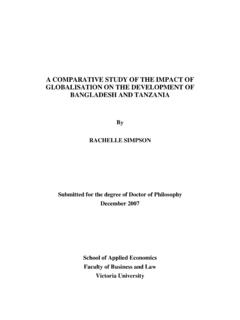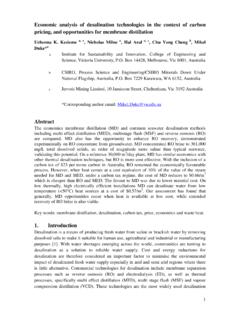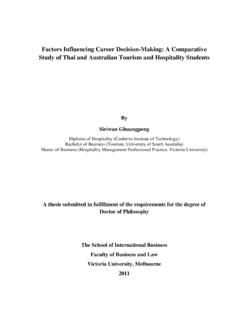Transcription of Parallels in Private and Public Sector Governance
1 Parallels in Private and Public Sector Governance Anona Armstronga, Xinting Jiab and Vicky Totikidisc a bc Centre for International Corporate Governance Research, Victoria University, PO Box 14428, Melbourne, VIC 8001, Australia Private Sector Governance , Governance in major listed companies, has caught much Public attention in recent years due to the collapses of major corporations around the world. The result has been a plethora of standards for corporate Governance in Public and Private companies. In comparison, Public Sector Governance has avoided much of the controversies while developing along a parallel , if dissimilar path of raised awareness of the need for Governance standards in the Public Sector . Examples of similarities that are markedly different in context are the role of agents, Public Sector managers manage funds on behalf the Public versus the role played by managers in corporations, and the involvement (or expected involvement) of different stakeholders in both the Public and the Private sectors.
2 This paper contrasts some of the differences in the models of Governance found in the Public and Private sectors, and makes some observations about the desirable attributes to be sought in each. Keywords: Public Sector Governance , Private Sector Governance , models of Governance Introduction In general corporate Governance is concerned with the structures and processes for decision-making, accountability, control and behaviour at the top of organisations (Spiller, 2004). It addresses the issues arising from the interrelationships between boards of directors, such as interactions with senior management and relationships with the owners and others interested in the affairs of the entity, including regulators, auditors, creditors, debt financiers and analysts (Standards Australia, 2003). The purpose of good Governance is to add value to the organisation, reduce financial, business and operational risk, strengthen shareholder confidence in the entity, and assist in the prevention of fraudulent, dishonest and unethical behaviour (Armstrong , 2004a).
3 The study of Governance is concerned with various Governance models. In the Private Sector these are found in the guidelines and standards for good Governance . Examples relevant in Australia are the OECD Guidelines (OECD, 1999), the Australian Stock Exchange Guidelines (Australian Corporate Governance Council, 2003) and the Governance standards developed by Standards Australia (Standards Australia, 2003). In the Public Sector in Australia, both Commonwealth and State Auditors-General have presented models of Governance . An example is the Victorian Auditor's model discussed below and shown in figure 2. Despite the fact that the general Public seldom link the Governance of the Private Sector with the Public Sector , Governance in both sectors has been moving closer. As acknowledged by the Uhrig Review (Uhrig, 2003, p. 26): There are benefits in looking to developments and lessons learnt in the Private Sector when considering appropriate Governance frameworks for the Public Sector .
4 The environment in which the Private Sector operates creates significant challenges for companies. The consequences of failure and threat of takeover provide incentives for the Private Sector to constantly strive to improve Governance practices. In dealing with the challenges of the market, the Private Sector has gained considerable experience in applying the core elements of Governance . The experience of the Private Sector has provided the review with valuable insights into the full spectrum of Governance arrangements and the corresponding impact on outcomes. There is an opposing view (for example, Wettenhall, 2004) that suggests that Governance experience in the Public Sector is long standing and that many of the criteria applied in the Private Sector are unsuitable for the Public Sector . 1. The type of Governance model adopted is influenced by the type of organisation structure involved. In the Private Sector , the most kind of enterprise is governed by the Corporations Law.
5 A company' which may be either a proprietary ( Private ) or Public company, listed with the stock exchange, but the law also applies to other entities such as partnerships and sole traders. Not-for-profit organisations may incorporate under the Associations and Incorporations Act in each State but since the board of the National Safety council, all volunteers, were held responsible for the losses of the corporation, the members of these boards are also responsible for decisions in the same way as the board of a company. Tomasic (2004) presents an overview of the rules governing corporations and in particular the duties and responsibilities of directors and other officers, the protection of stakeholder interests, and remedies for breach of corporate Governance provisions. Similar provisions apply in the Public Sector , but the form of entity and the context in which Public Sector organisations operate is much more complex. Public Sector orgnaisations with Governance implications include a diversity of departments, statutory bodies (eg.)
6 Universities, Workcover), State owned enterprises, partly owned Public companies ( Telstra), Public / Private partnerships and various kinds of advisory committees. Partnership arrangements can include arrangements with other Public entities, Private enterprises and non-profit and service providers. The context is muddied by Ministerial directions, reporting requirements that may be to Ministers or Departments or to the Public . In most cases the elements of both Private and Public Sector Governance models (see Table 1) refer to the Governance structure of organisations (see for example, Standards Australia, 2003), the underlying principles, values and ethics of an organisation (Francis, 2004), the relevant law (Tomasic, 2004), and the theories held by different disciplines about good Governance mechanisms (Armstrong, 2004b). Table 1. Some of the elements included in models of Governance Structures Organisation models Values Accountability Transparency Honesty Integrity Diligence Diversity Equality Excellence Principles Governance policies Role, powers, conduct of board Provision of Governance infrastructure Relevant law Constitutional Statutory (Corporations, CAC) Law Regulatory (OH&S, Whistleblower protection).
7 Good Governance Mechanisms Leadership Direction Control Authority Stewardship Accountability 2. Several organisations have identified values relevant to Governance . For example, Standards Australia (2003) in its Good Governance Principles lists the values: accountability, transparency, fairness and balance, honesty, dignity, goodwill. Another value often stated in the Private Sector is customer service. The Victorian Public Administration Act 2004 sets out values of responsiveness, integrity, impartiality, accountability, respect and leadership. Victoria University has its own set of values: knowledge and skills and critical and imaginative inquiry, equality of opportunity for students and staff, diversity, co-operation, integrity, and excellence. The principles which enable good Governance are Governance policies, infrastructure and actions to be taken to implement various good Governance measures. The latter refer to board composition including selection and member skill profiles, the method of appointment of directors, structure and membership of audit and other committees and board operations and procedures.
8 These complement the mechanisms for achieving good Governance . Good Governance mechanisms refer to the processes that provide answers to the question how well is the organisation managed and are demonstrated through the assessment of leadership, direction and control, authority, stewardship, and accountability. Leadership refers to how well the chair and board set the strategic vision and direction for the entity and add value to the program. It relies on clarity about roles and responsibilities and compliance with ethical and Governance standards. Stewardship refers to the structures, systems and processes for decision making and control, communication and financial responsibilities, risk management and compliance. Accountability address standards of behaviour and systems in place for auditing, risk management and reporting procedures. Some differences in Governance between the Public and Private sectors are listed in Table 2. Table 2. Some differences in Governance between the Public and Private sectors Governance Private Sector Public Sector Organisation structure Enterprise: Department Outsider/insider models Statutory Authority State owned enterprise Private / Public partnerships Regulation Corporations Act Commonwealth Corporations Act State Owned Enterprises Act 1992.
9 Statutory legislation Regulated Regulator and regulated Agents For Shareholders For Public Objectives Profit Public good Origin of Governance model ASX Auditors General Standards Australia Public Service Commissioner Authority Board Government Minister/s Department Board Responsibility Legal Responsibility of board Responsibility diffused Independence Legal Independence of board Ministerial control Selection and appointment of 3. Governance Private Sector Public Sector members Accountability To shareholders Diffuse Reporting Annual Report to shareholders Ministers Parliament Auditor general Agency Heads Treasury and Finance Public and Private Sector Governance in essence share some basic common characteristics. It is the context in which they are embedded that drives the differences. The similarities are: in the Private Sector , managers acting as the agents for shareholders oversee the day-to-day management of the listed company. In parallel , in the Public Sector , the officials of the Public Sector (the Public servants) acting as the agent of tax payers manage the Public organisation for the purpose of serving the best interest of the general Public (although it is often debatable on what is really the best interest for the general Public ).
10 In terms of managing the interests of various stakeholders, in the case of the Private Sector , now, there is an increasing consensus among controllers of publicly listed companies that the company should not only serve the best interest of the shareholders, it should also consider the interest of other stakeholders of the company such as the interest of employees, customers, suppliers as well as the interest of the local community where the corporation is operating. In the case of the Public Sector , various levels of governments will have different stakeholders but the ultimate aim is to serve the Public interest and provide services to the community on behalf of the government (Uhrig, 2003, ), and at the same time to provide adequate solutions when market failure is likely to happen (Uhrig, 2003, ). Differences between the Public Sector and the Private Sector Governance are also obvious: they serves different interest groups and the Public Sector is subject to much greater scrutiny.










